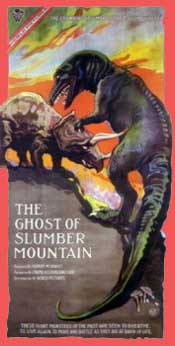 Willis O'Brien made short stop motion animation silent films before he did his classic work for The Lost World (1925) & King Kong (1933). Willis O'Brien made short stop motion animation silent films before he did his classic work for The Lost World (1925) & King Kong (1933).
In these earlier films, the cast of dinosaurs & cave men stop-motion puppets have the primary purpose of comedy. Three of these short films just about function as "chapters" of a continuous work or set in a shared location of the prehistoric world; the fourth is a more individual work.
The Dinosaur & the Missing Link: A Prehistoric Tragedy (1915) is highlighted by the misadventures of an ape-man (shown in the still photo at top of page). The ape-man gets killed for mistaking a brontosaur's tail-tip for an edible snake. A cave man stumbles upon the body & in order to impress a girl pretends he killed the ape-man himself.
R.F.D. 10,000 B.C.: A Mannikin Comedy (1916) is a cave man Valentine story again centering on the desire of prehistoric man to win over prehistoric woman. The coolest image is of the brontosaur used to operate the mail delivery cart. Some of this certainly prefigures The Flintstones.
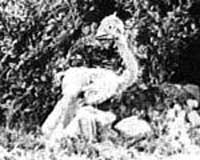 Prehistoric Poultry: The Dinornis or Great Roaring Whiffenpoof (1916) is a comedy with the gigantic ancestor of the chicken being the primary star, playing tricks on cavemen. Prehistoric Poultry: The Dinornis or Great Roaring Whiffenpoof (1916) is a comedy with the gigantic ancestor of the chicken being the primary star, playing tricks on cavemen.
The most elaborate & last of Willis O'Brien's stop-motion shorts is The Ghost of Slumber Mountain (1918).
The spirit of the mountain hermit Mad Dick (Willis O'Brien) provides tale-spinner Uncle Jack (Herbert M. Dawley) with a time-viewing telescope. through which Jack is able to see a dinosaur fight millions of years ago.
All of these are rather primitive warm-ups for stop motion animator Willis O'Brien's special FX sequences for The Lost World.
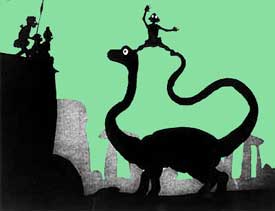 One of the most stunning pieces of animation from the silent era is The First Circus (1921) which begins with the text card: "In 1871 P. T. Barnum started his now world famous circus" then shows a circus parade in silhouette, circus tents in the background. One of the most stunning pieces of animation from the silent era is The First Circus (1921) which begins with the text card: "In 1871 P. T. Barnum started his now world famous circus" then shows a circus parade in silhouette, circus tents in the background.
The film consists of silhoettes, like black paper cut-outs sprung to life, with tinted frames adding the illusion of a color film.
The second text card reads, "But he was small potatoes compared to Stonehenge Circus 30,009 years ago."
Thus begins our visit to the prehistoric circus, with a placid brontosaurus which has a trainer on its back & the Stonehenge circle visible in the background.
For the gathered spear-carrying crowd the trainer does a series of stunts on the bronty's back, with assistance from the obedient beast's long tail.
Then a ballerina with parasol comes out to sit on the bronty's head while a giant python stretches from neck to upraised tail & the ballerina does a highwire act above the bronty's back.
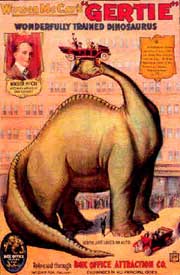 An early example of claymation is Monsters of the Past (1923) which is an episode of the silent newsreel series called Pathe Review, featuring the work of sculptress Virginia May, & showing her in time lapse making one of the clay dinosaurs. An early example of claymation is Monsters of the Past (1923) which is an episode of the silent newsreel series called Pathe Review, featuring the work of sculptress Virginia May, & showing her in time lapse making one of the clay dinosaurs.
The stop-motion dinosaur battle is pretty much what would be seen in O'Brien's animation for The Lost World two years later, though with less detail to the dinosaurs.
All five of these films are of historical interest but not all that inspiring in & of themselves. The drawn-animation of Windsor McKay for Gertie the Dinosaur (1914) by comparison has a greater inherent appeal, besides its historical position of considerable consequence.
Windsor, best remembered for his classic Little Nemo in Slumberland comic strip, had done his first fragmentary animation of Little Nemo in 1911 Nemo, to incorporate in his vaudeville act. Many thought the limited animation of the Nemo short was a trick of some sort & refused to believe the drawings were really moving.
So when Windsor undertook the painstaking Gertie, he made her story & movements sufficiently elaborate that no one could doubt his drawings were in motion. He made Gertie an emotional interactive being of lasting charm so that during his act he could command her to do specific movements, & at one point chastise her so that she actually cries.
While performing his "moving comics" Vaudeville lecture Winsor always claimed to be the inventor of this new art form, which of course he was not, but one of the important pioneers certainly.
For more dinosaurs, continue to:
Versions of Arthur Conan Doyle's Lost World (1925, 1950, 1992)
copyright © by Paghat the Ratgirl
|
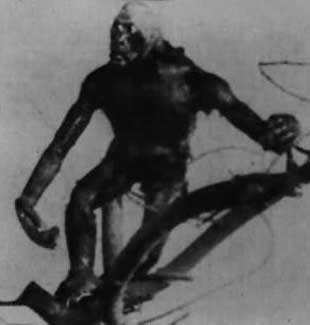

 Prehistoric Poultry: The Dinornis or Great Roaring Whiffenpoof (1916) is a comedy with the gigantic ancestor of the chicken being the primary star, playing tricks on cavemen.
Prehistoric Poultry: The Dinornis or Great Roaring Whiffenpoof (1916) is a comedy with the gigantic ancestor of the chicken being the primary star, playing tricks on cavemen.
